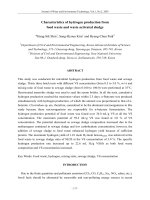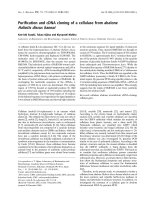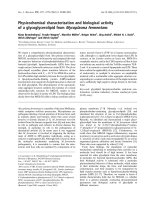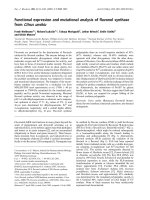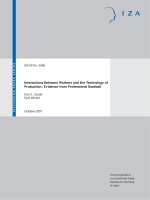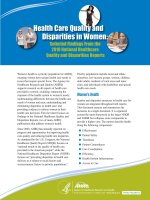Accurate and sensitive determination of selected contaminants from food packaging materials
Bạn đang xem bản rút gọn của tài liệu. Xem và tải ngay bản đầy đủ của tài liệu tại đây (1.16 MB, 209 trang )
ACCURATE AND SENSITIVE DETERMINATION
OF SELECTED CONTAMINANTS FROM
FOOD PACKAGING MATERIALS
SUN CUILIAN
B. Sc (Hons)
A THESIS SUBMITTED FOR THE DEGREE OF DOCTOR
OF PHILISOPHY
FOOD SCIENCE AND TECHNOLOGY PROGRAMME
DEPARTMENT OF CHEMISTRY
NATIONAL UNIVERSITY OF SINGAPORE
2009
- I -
Acknowledgements
I wish to express sincere gratitude to the National University of Singapore for
providing me with a research scholarship to start my postgraduate studies, and the
Food Safety Laboratory, Applied Sciences Group at the Health Sciences Authority for
providing the opportunity for this collaborative study, as well as their generous funding
for the continuation of my research as I converted my full-time studies to a part-time
basis in April 2006. I would also like to express my grateful appreciation to Dr Philip
John Barlow for his mentorship. In addition, I wish to extend my heartfelt appreciation
to Dr Leong Lai Peng, Professor Bosco Chen Bloodworth and Ms Joanne Chan for
their patient supervision; Ms Lee Chooi Lan (FST), Ms Lew Huey Lee (FST) and Mrs
Poon-Yeo Siew Lan (HSA), and Dr Matthew E. Grigg (Applied Biosystems Ltd.), Dr
Lee Teck Chia (Applied Biosystems Ltd.) for their technical assistance and support. I
would also like to express my gratitude to Mr Chua Yong Guan Peter for assisting me
in the optimization of the sample preparation protocol for the determination of the five
photoinitiators in my last chapter of the thesis.
Last but not least, I am always grateful to my parents for their endless loving support,
financial support and care throughout the entire project. Special thanks goes to my
husband, Mr Darrick Toh, for his encouragement, without him I would never have
- II -
completed this thesis on time. I would also like to dedicate this project to my late father
who passed away in 2008. He would have been proud to witness this moment.
- III -
TABLE OF CONTENTS
Page
ACKNOWLEDGEMENTS I
TABLE OF CONTENTS III
SUMMARY XIII
LIST OF TABLES XVI
LIST OF FIGURES XIX
ABBREVIATIONS XXII
LIST OF PUBLICATIONS XXIV
CHAPTER 1: INTRODUCTION 1
1.1 Background 2
1.2 Coatings used in canning 3
1.2.1 Epoxy resins 4
1.2.2 Advantages of epoxy phenolic resins 7
1.2.3 Toxicology of bisphenolic compounds 7
1.3 Determination of bisphenolic analytes from canned coatings in
food
10
1.4 Ink systems in food packaging 11
1.4.1 Solvents 12
1.4.2 Colourants 12
1.4.3 Resins 13
1.4.4 Additives 13
1.4.5 Types of ink systems
14
- IV -
Page
1.4.5.1 Solvent based inks 14
1.4.5.2 Water based inks 14
1.4.5.3 Ultraviolet (UV) cured inks 15
1.5 Migration of contaminants from food contact materials (FCM) 16
1.5.1 Migration of monomers / additives from polymers used
in food contact materials
17
1.6 State-of-the-art analytical methods for determining amount of
contaminants from food packaging materials
18
1.6.1 Ultra-performance Liquid Chromatography (UPLC
TM
) 18
1.6.2 Liquid Chromatography Tandem MS (LC-MS/MS) 20
1.6.2.1 Electrospray Ionisation (ESI) 21
1.6.2.2 Tandem Mass Spectrometry
22
1.7 Objectives of the research work
23
1.8 References
30
CHAPTER 2: OPTIMISATION OF BISPHENOL A, BISPHENOL F,
BISPHENOL A DIGLYCIDYL ETHER AND ITS DERIVATIVES IN
CANNED FOOD BY HPLC
34
2.1 Introduction 35
2.2 Chemicals and standards 36
2.3 Apparatus 37
2.3.1 HPLC Analysis 38
2.4 Samples 39
2.5 Sample Preparation 39
2.5.1 Extraction of bisphenolic analytes from food 39
- V -
Page
2.6 Optimization of sample extraction method 41
2.6.1 Liquid-liquid extraction clean-up efficiency 41
2.6.2 Suitability of SPE wash solvent 42
2.6.3 SPE elution solvent efficiency 43
2.6.4 Chromatographic Analysis 44
2.7 Method Validation 45
2.7.1 Linearity, LOD and LOQ, and Robustness 45
2.7.2 Precision 47
2.7.3 Accuracy 47
2.8 Analysis of Canned Food Samples 47
2.9 Conclusions 50
2.10 References
51
CHAPTER 3: SIMULTANEOUS DETERMINATION OF BISPHENOL A,
BISPHENOL F, BISPHENOL A DIGLYCIDYL ETHER AND ITS
DERIVATIVES, AND BISPHENOL F DIGLYCIDYL ETHER AND ITS
DERIVATIVES FROM CANNED SUBSTRATES INTO CANNED FOODS
USING REVERSED PHASE- HIGH PERFORMANCE LIQUID
CHROMATOGRAPHY WITH FLUORESCENCE DETECTION
52
3.1 Introduction
53
3.2 Chemicals and standards
55
3.3 Apparatus
56
3.4 Samples
57
3.5 Sample Preparation
59
3.5.1 Extraction of residual bisphenolic analytes from can
lacquer
59
- VI -
Page
3.5.2 Separation of solid and liquid portions in can food
60
3.5.3 Determination of bisphenolic analytes in can food
60
3.6 Method Validation
62
3.6.1 Linearity, Range, LOD and LOQ, and Robustness
62
3.6.2 Precision and Accuracy
63
3.7
Analysis of Can Food Samples
67
3.7.1
Effect of the oily food matrix on the migration profile of
bisphenolic analytes in solid and liquid food portions
67
3.7.2
Effect of the aqueous food matrix on the migration
profile of bisphenolic analytes in solid and liquid food portions
69
3.8
Conclusions
72
3.9 References
73
CHAPTER 4: A FAST DETERMINATION OF BISPHENOL A,
BISPHENOL F, BISPHENOL A DIGLYCIDYL ETHER AND ITS
DERIVATIVES, AND BISPHENOL F DIGLYCIDYL ETHER AND ITS
DERIVATIVES IN CANNED FOOD BY ULTRA PERFORMANCE
LIQUID CHROMATOGRAPHY (UPLC
TM
)
75
4.1 Introduction
76
4.2 Experimental
77
4.2.1 Materials and Reagents
77
4.3 Apparatus
78
4.4 Samples
79
4.5 Sample Preparation
79
- VII -
Page
4.6 Results and Discussion
81
4.6.1 Chromatographic Analysis
81
4.6.2 Method Validation
82
4.6.2.1 Linearity, Range, LOD and LOQ and Robustness
82
4.6.2.2 Precision and Accuracy
83
4.6.3 Quality Assurance
83
4.6.4 Improvements to the method
84
4.7 Conclusions
86
4.8 References
87
CHAPTER 5: A SPECIFIC METHOD FOR THE SIMULTANEOUS
DETERMINATION OF BISPHENOL A, BISPHENOL F, BISPHENOL A
DIGLYCIDYL ETHER AND ITS DERIVATIVES, AND BISPHENOL F
DIGLYCIDYL ETHER AND ITS DERIVATIVES IN CANNED
BEVERAGES BY POSITIVE AND NEGATIVE ESI-LIQUID
CHROMATOGRAPHY-TANDEM MS
88
5.1
Introduction
89
5.2
Experimental
91
5.2.1 Materials and Reagents
91
5.3
Apparatus
92
5.3.1 LC-MS/MS
92
5.3.2 HPLC
94
5.3.3 Fourier Transform Infrared (FTIR) Spectrophotometer
95
- VIII -
Page
5.4 Samples
95
5.5 Sample Preparation
96
5.5.1 Determination of canned coating type
96
5.5.2 Determination of bisphenolic analytes in canned coffee
samples
97
5.6 Results and Discussion
97
5.6.1 FTIR analyses of cans
97
5.6.2 Chromatographic Analysis
98
5.6.2 Method Validation
101
5.6.2.1 Linearity, Range, LOD and LOQ and Robustness
101
5.6.2.2 Precision and Accuracy
102
5.6.2.3 Selectivity and Specificity
104
5.7 Conclusions
107
5.8 References
108
CHAPTER 6: MEASUREMENT UNCERTAINTIES OF BISPHENOL A,
BISPHENOL F, BISPHENOL A DIGLYCIDYL ETHER AND ITS
DERIVATIVES, AND BISPHENOL F DIGLYCIDYL ETHER AND ITS
DERIVATIVES BY REVERSED PHASE- HIGH PERFORMANCE LIQUID
CHROMATOGRAPHY WITH FLUORESCENCE DETECTION
110
6.1 Introduction
111
6.2 Precision study (Inter-day)
113
6.3 Bias Study
115
- IX -
Page
6.3.1 Calculation of bias based on recovery data
116
6.4 Other Sources of Uncertainty
119
6.4.1 Balances/ Volumetric Measuring Devices
119
6.4.2 Sample Homogeneity
120
6.5 Reference Material Purity
120
6.6 Summary of Uncertainty Estimation of BADGE method
121
6.7 Conclusions
122
6.8 References
123
CHAPTER 7: DETERMINATION OF ISOPROPYL-9H-THIOXANTHEN-
9-ONE IN PACKAGED BEVERAGES BY SOLID PHASE EXTRACTION
CLEAN-UP AND LIQUID CHROMATOGRAPHY WITH TANDEM MASS
SPECTROMETRY DETECTION
124
7.1 Introduction
125
7.2 Experimental
127
7.2.1 Materials and Reagents
127
7.3 Apparatus
128
7.4 Samples
129
7.5 Sample Preparation
130
7.6 Results and Discussion
131
7.6.1 Optimization of MS parameters
131
7.6.2 Method Validation
133
7.6.2.1 Linearity, Range, LOD and LOQ
133
7.6.2.2 Precision and Accuracy
134
- X -
Page
7.6.2.3 Robustness
135
7.6.3 Analysis of Food Samples
136
7.7 Conclusions
140
7.8 References
141
CHAPTER 8: MEASUREMENT UNCERTAINTY OF ISOPROPYL-9H-
THIOXANTHEN-9-ONE IN PACKAGED BEVERAGES BY SOLID
PHASE EXTRACTION CLEAN-UP AND LIQUID CHROMATOGRAPHY
WITH TANDEM MASS SPECTROMETRY DETECTION
143
8.1 Introduction
144
8.2 Precision study (Inter-day)
146
8.3 Bias Study
148
8.3.1 Calculation of bias based on recovery data
149
8.4 Other Sources of Uncertainty
152
8.4.1 Balances/ Volumetric Measuring Devices
152
8.4.2 Sample Homogeneity
152
8.4.3 Reference material purity
152
8.4.3.1 ITX standard
152
8.4.3.2 d
7
-ITX internal standard
153
8.5 Summary of Uncertainty Estimation of ITX
154
8.6 Conclusions
155
8.7 References
156
- XI -
Page
CHAPTER 9: DETERMINATION OF BENZOPHENONE, ISOPROPYL-
9H-THIOXANTHEN-9-ONE, THIOXANTHEN-9-ONE, 2,4-
DIMETHYLTHIOXANTHEN-9-ONE, 2-CHLOROTHIOXANTHEN-9-ONE
IN PACKAGED BEVERAGES BY SOLID PHASE EXTRACTION CLEAN-
UP AND LIQUID CHROMATOGRAPHY WITH TANDEM MASS
SPECTROMETRY DETECTION
157
9.1 Introduction
158
9.2 Experimental
161
9.2.1 Materials and Reagents
161
9.3
Apparatus
164
9.4 Samples
165
9.5 Sample Preparation
166
9.6 Results and Discussion
167
9.6.1 Optimization of Sample Preparation – Extraction
Solvent
167
9.6.2 Optimisation of SPE Protocol – Wash Solvent
169
9.6.2.1 Deionised Water
169
9.6.2.2 Acetonitrile: Deionised Water
170
9.6.3 Optimization of Mobile Phase Gradient
172
9.6.4 Method Validation
173
9.6.4.1 Linearity. Method Detection Limit (MDL) and Method
Quantification Limit (MQL)
173
9.6.4.2 Precision and Accuracy
176
9.7 Analysis of real beverage samples
179
9.8 Conclusions
180
9.9 References
181
- XII -
Page
APPENDIX I – LIST OF 35 SAMPLES ANALYSED FOR BISPHENOLIC
CONTENT
A1
APPENDIX II – PUBLICATIONS IN INTERNATIONAL SCIENTIFIC
JOURNALS
A2
- XIII -
SUMMARY
This research project has investigated the migration of various types of toxic
contaminants from food packaging materials into oily, aqueous and acidic food
matrices. The first part of the project focuses largely on the development and
optimization of various analytical methods for the investigation of bisphenolic
analytes, namely bisphenol A (BPA), bisphenol A diglycidyl ether (BADGE),
BADGE-H
2
O, BADGE-2H
2
O, BADGE-H
2
O-HCl, BADGE-HCl, BADGE-2HCl,
bisphenol F (BPF), bisphenol F diglycidyl ether (BFDGE), BFDGE-2H
2
O, BFDGE-
2HCl in inner coatings of canned foods, as well as their migrational tendency into food
using reversed phase high performance liquid chromatography (HPLC) with
fluorescence detection. Acetonitrile was used to extract the analytes from the food
matrix before subjecting the samples to liquid-liquid extraction, solid-phase extraction
for further clean-up and preconcentration prior to HPLC analysis. The excellent
validation data obtained suggests that this method can be applied to canned foods for
the determination of migration of the eleven bisphenolic analytes from can coatings
into food. Analytical results indicated that although migration levels of bisphenolics
increased with storage time, the rates were different in different food matrices.
Additionally, the type of food matrix influenced the major type of BADGE compounds
present in the samples. The residual levels of the bisphenolic analytes present in the
inner can coatings of thirty-five types of canned foods were also investigated; can tops,
can bodies, and can bottoms were analyzed separately for their residual analyte content.
- XIV -
The extent of migration of all eleven analytes into the canned foods was examined in
foods consisting of both solid and aqueous portions in a comparative analysis. The
HPLC method was also transferred to the ultra-performance liquid chromatograph
(UPLC
TM
) to allow for an improvement in separation efficiency, better
chromatographic resolution and throughput. With the use of the UPLC, analytical run-
time was improved by more than 300 %, and sensitivity of the various analytes was
enhanced by more than 3 times.
During the liquid chromatographic analyses it was recognized that food matrices
sometimes have interferences that hinder accurate chromatographic identification and
quantitation. Therefore, a selective and specific method consisting of liquid
chromatograph tandem mass spectrometry (LC-MS/MS) in multi-reaction monitoring
mode was developed for the confirmation and quantitation of these bisphenolic
analytes. The use of the LC-MS/MS methodology provided additional confidence and
reliability for the identification of the analytes studies, with respect to the food
interferences often present in food matrixes.
In the second part of the project, the migration of photoinitiators, such as
benzophenone (BP), isopropyl-9H-thioxanthen-9-one (ITX), thioxanthen-9-one (TX),
2,4-dimethylthioxanthone (DMTX), and 2-chlorothioxanthen-9-one (CTX), from
printed food packaging materials and beverages were also determined by the highly
specific and sensitive LC-Tandem MS with electrospray ionization (ESI) using the
multi-reaction monitoring mode. These photoinitiators are usually present in inks
- XV -
applied to printed food packaging materials for functional purposes. Investigation of
the ITX content in the food carton-boxes confirmed that ITX has been widely applied
to the inks used in the food packaging material. The subsequent simultaneous
analytical method developed for five photoinitiators, namely, benzophenone,
isopropyl-9H-thioxanthen-9-one, thioxanthen-9-one, 2, 4-dimethylthioxanthone, and 2-
chlorothioxanthen-9-one allowed for efficiency and convenience for food surveillance
institutions.
- XVI -
LIST OF TABLES
Page
Table 1.1
Summary of results available from other research groups
11
Table 2.1
Recoveries of analytes obtained using different types of SPE elution
solvents from the optimization process. Analytes that were found below
the limit of detection are labeled as ND.
43
Table 2.2
Linearity (n=3) and LODs of various bisphenolic analytes determined
during the study.
46
Table 2.3
Results of the analysis of various canned foods (n=2). Analytes that were
found below the limit of detection were labeled as ND. Fortified samples
(w/w) were prepared by pipetting a small volume of stock standard
solution into the round bottomed flask, and gently evaporating off the
solvent using a stream of nitrogen gas. 5 g of the appropriate food
simulant was then weighed into the same vessel for recovery studies
using the sample preparation method described.
49
Table 3.1
Summary of can food samples analysed in the study.
58
Table 3.2
Retention times, correlation coefficient, LOD, and LOQ of the individual
analytes in their respective concentration ranges.
63
Table 3.3
Recovery studies (n = 10) at 100, 500, and 2000 µg/kg level using
fortified oil samples; interday precision results (n =8) and intraday
precision results (n =5) results using a 100 µg/L mixed standard solution
containing all bisphenolic analytes
65
Table 3.4
Results of BPA and BADGE-based analytes, and BPF and BFDGE-
based analytes in S8.
69
Table 4.1
Retention times of the bisphenolic analytes analysed using the UPLC.
Isomers of the analytes are differentiated by -1; -2 or -3. (i.e. Peak at
12.244 min is the first isomer of BFDGE)
82
- XVII -
Table 4.2
Comparison of limits of detection (LOD)s of the various bisphenolic
analytes between the UPLC method and the conventional HPLC method.
86
Table 5.1
LC-MS/MS parameters of the various bisphenolic analytes determined
93
Table 5.2
LODs, LOQs and concentration ranges of the various analytes by the
reported LC-MS/MS method in this chapter, and the HPLC method
(discussed in Chapter 3).
102
Table 5.3
Comparison of experimental results for T1224 and T1226, analysed in
duplicate, with respect to the assigned values from FAPAS.
104
Table 6.1
Interday precision results (n =8) determined using a 100 µg/L mixed
standard solution containing all bisphenolic analytes performed over
three days, with RSD % values in parenthesis.
114
Table 6.2
Results of recovery (bias) study at 100, 500, and 2000 µg/kg levels, with
RSD % values in parenthesis.
115
Table 6.3
Two-tailed critical t
α
values of Students’ t variables at 95 % Confidence
intervals.
118
Table 6.4
Two-tailed Students’ t values at 95 % Confidence intervals.
118
Table 6.5
Purities and uncertainties associated with the standards, as given in the
certificates of analysis.
120
Table 6.6
Overall uncertainty estimation of BADGE procedure
121
Table 7.1
MS parameters for ITX and ITX-d
7
mass pairs.
132
Table 7.2
MDL, MQL values of ITX (with reference to the internal standard, 262.4
/ 214.5 ) analysed within the range of 0.1 μg/L to 100 μg/L. Precision
data (both interday (n=10), and intraday (n=5)); and mean recoveries of
ITX are provided with the RSD values stated within parenthesis.
134
Table 7.3
Results of ITX in food and in the respective food packaging materials.
138
Table 8.1
Inter-day Precision study for ITX
147
Table 8.2
Results of recovery (bias) study at 0.5, 20 and 100 ng/g levels.
148
- XVIII -
Table 8.3
Two-tailed critical t
α
values of Students’ t variables at 95 % Confidence
intervals.
150
Table 8.4
Overall uncertainty estimation of ITX procedure
154
Table 9.1
Mass spectrometry settings used in the optimized method.
165
Table 9.2
Recovery at different composition of extracting solvent (deionised water
containing 1 % of Carrez reagents 1 and 2) : acetonitrile, v/v.
168
Table 9.3
Recovery of analytes after varying the amount of wash solvent (water)
170
Table 9.4
Recoveries of analytes after incorporating an additional step of different
proportions of acetonitrile : deionised water, v/v.
171
Table 9.5
Mobile phase gradient and the respective analytical run time conditions.
172
Table 9.6
Linearity of various photoinitiators (n=6)
174
Table 9.7
MDL, MQL values of the various photoinitiators determined in fruit
juice and milk matrices (with reference to the respective internal
standard) analysed within the range of 10 to 500 μg/L.
175
Table 9.8
Intra-day (n = 6) and inter-day (n = 3) precision data on fortified spiked
juice and milk samples.
177
Table 9.9
Mean percentage recoveries for photoinitiators in both fruit juice and
milk samples.
179
Table 9.10
Results of photoinitiator content in various beverage samples.
180
- XIX -
LIST OF FIGURES
Page
Figure 1.1
Formation of epoxy phenolic resins using BPA as starting material
5
Figure 1.2
Reaction mechanisms of BADGE to form BADGE derivatives 6
Figure 1.3
List of all bisphenolic analytes in this study
24
Figure 1.4
Chemical structures of the range of photoinitiators used in the study
using LC-MS/MS
28
Figure 2.1
Chemical structures of BPA and bisphenolic analytes optimized in this
study.
36
Figure 2.2
Recoveries of liquid-liquid extraction (n = 3) based on different
extraction times
41
Figure 2.3
Effect of different methanol solutions as SPE wash solvents on analyte
retention in the SPE cartridges.
42
Figure 2.4
Fully resolved chromatographic separation of a standard mixture
containing all seven BPA and BADGE analytes at 1500 µg/L level.
44
Figure 3.1
HPLC Chromatogram of a 400 μg/L mixed standard solution using
fluorescence detection
62
Figure 3.2
Graphical presentation of the precision results of analytes (100 μg/kg), n
= 8; Linearity : 100– 2000 μg/L
66
Figure 3.3
Accuracy results on 100, 500 and 2000 μg/kg spiked samples (n = 10)
66
Figure 3.4
Total bisphenolic analyte levels (in percentages) in solid and liquid
portions of various food samples.
68
Figure 3.5
Proportions of bisphenol A- type analytes (in percentages) detected in
can and food
70
- XX -
Figure 3.6
Proportions of bisphenol F- type analytes (in percentages) detected in can
and food
71
Figure 4.1
Chromatographic separation of the mixture of 11 bisphenolic analytes at
1 mg/L, where 1. BFDGE-2H
2
O-1, 2.BFDGE-2H
2
O-2, 3. BADGE-
2H
2
O, 4. BPF, 5. BPA, 6. BADGE-H
2
O-HCl, 7. BADGE-H
2
O, 8.
BFDGE-2HCl-1, 9. BFDGE-1, 10. BFDGE-2, 11. BFDGE-2HCl-2, 12.
BFDGE-3, 13. BADGE-2HCl, 14. BADGE-HCl, 15. BADGE.
81
Figure 4.2
HPLC Chromatogram of a 400 μg/L mixed standard solution using
conventional HPLC with fluorescence detection
85
Figure 5.1
Comparison of FTIR spectrums between the internal coating applied on
the test can, with respect to the FTIR spectrum of an epoxy resin – the
top image (A) illustrates the FTIR scan of the internal can coating and
the bottom image (B) illustrates the epoxy resin FTIR spectrum as
provided by the polymer library.
98
Figure 5.2
Positive ESI-LCMS/MS chromatogram illustrating nine bisphenolic
analyte peaks at 50 μg/L, where 1. BFDGE-2H
2
O, 2. BADGE-2H
2
O, 3.
BADGE-H
2
O-HCl. 4. BADGE-H
2
O, 5. BFDGE-2HCl, 6. BFDGE-1, 7.
BFDGE-2, 8. BFDGE-2HCl, 9. BFDGE-3, 10. BADGE, 11. BADGE-
HCl
99
Figure 5.3
Negative ESI-LC-MS/MS chromatogram of BPA and BPF at 5 mg/L
100
Figure 5.4
Sensitivities of BPA and BPF in negative ESI mode, with respect to the
type of aqueous modifier used.
101
Figure 5.5
Percentage recoveries (n = 8) in fortified coffee at 40 μg/kg.
103
Figure 5.6
HPLC chromatogram of in-house canned coffee blank, analyzed
separately on the Shimadzu system, as described in Section 4.3.2
105
Figure 5.7
Confirmation of bisphenolic analytes (BADGE-2H
2
O and BFDGE-
2H
2
O) from the canned coffee sample.
106
Figure 7.1
Chemical structures of ITX-d
7
and ITX (2- and 4- isomers).
127
Figure 7.2
Product ion scan mass spectra of 500 μg/L ITX standard in positive
mode.
132
Figure 7.3
Linearity of ITX mass pair (255.0 / 184.1) in the range of 0.1 – 100.0
µg/L.
133
- XXI -
Figure 7.4
Linearity of ITX mass pair (255.0 / 213.3) in the range of 0.1 – 100.0
µg/L.
134
Figure 7.5
Signal- to- noise (S/N) ratio of the 2 qualifying mass pairs of ITX at 0.1
μg/L level in the MRM spectrum.
135
Figure 7.6
Correlation between affected samples and the residual ITX content in
food packaging material.
139
Figure 9.1
Polymerisation reaction mechanism of photoinitiators
159
Figure 9.2
Chemical structures of all the photoinitiators in this study
163
Figure 9.3
Chromatogram of a 10 ng/L standard solution containing the five
photoinitiators studied.
173
Figure 9.4
Spiked linearity curve for CTX in liquid milk matrix at the concentration
levels of 10, 20, 50, 100, 200, and 500 μg/L.
175
- XXII -
List of Abbreviations
1-HCPK
1-hydroxycyclohexyl-phenylketone
ASE
Accelerated solvent extraction
BADGE
Bisphenol A diglycidyl ether
BADGE-2H
2
O
Bisphenol A bis(2,3-dihydroxypropyl)ether
BADGE-2HCl
Bisphenol A bis (3-chloro-2-hydroxypropyl) ether
BADGE-H
2
O
Bisphenol A (2,3-dihydroxypropyl) glycidyl ether
BADGE-H
2
O-HCl
Bisphenol A (3-chloro-2-hydroxypropyl)(2,3-dihydroxypropyl) ether
BADGE-HCl
Bisphenol A (3-chloro-2-hydroxypropyl)glycidyl ether
BFDGE
Bisphenol F diglycidyl ether
BFDGE-2H
2
O
Bisphenol F bis(2,3-dihydroxypropyl)ether
BFDGE-2HCl
Bisphenol F bis (3-chloro-2-hydroxypropyl) ether
BfR
Bundesinsitit fuer Risikobewertung (Federal Institute for Risk Assessment)
BP
benzophenone
BPA
Bisphenol A [(2,2’bis(4-hydroxyphenyl)propane ]
BPF
Bisphenol F
CE
Capillary electrophoresis
CE
Collision Energy
CTX
2-chlorothioxanthen-9-one
CV
Coefficient of variation
CXP
Collision Cell Exit Potential
D
Daltons
DMTX
2, 4-dimethylthioxanthone
DP
Declustering Potential
EC
European Commission
EDC
Endocrine disrupting chemicals
EFSA
European Food Safety Authority
EP
Entrance Potential
EPA
Environmental Protection Agency (United States of America)
ESI
Electrospray ionisation
EU
European Union
FAPAS
Food analysis proficiency assessment scheme
FCM
Food Contact Material
FP
Focusing Potential
- XXIII -
FTIR
Fourier Transform Infrared (Spectrophotometry)
GC
Gas chromatography
GC-MS
Gas chromatography- mass spectrometry
HDPE
high density poly(ethylene)
HPLC
High performance liquid chromatography
HPLC-DAD/FLD
High performance liquid chromatography with diode array detection and
fluorescence detection
HPTLC
High performance thin layer chromatography
ITX
isopropyl-9H-thioxanthen-9-one
ITX-d
7
2-isopropyl-[2H7]-thioxanthen-9-one
LC
Liquid chromatographs
LC-MS
Liquid chromatography mass spectrometry
LC-MS/MS
Liquid chromatography tandem mass spectrometry
LDPE
low density poly(ethylene)
LOD
Limit of Detection
LOQ
Limit of Quantitation
MDL
Method detection limit
MGEBPA
Monoglycidyl ether of BPA
MQL
Method quantitation limit
MRM
Multi-reaction monitoring mode
MS
Mass spectrometer
MS/MS
Tandem mass spectrometry
ND
Not Detected
NOGE
Novolac glycidyl ethers
PVC
Poly(vinyl chloride)
RP
Reversed Phase (HPLC)
rpm
Revolutions per minute
RSD
Relative standard deviation
S/N
Signal to noise ratio
SD
Standard deviation
SML
Specific migration limits
SPE
Solid phase extraction
TDI
Tolerable Daily Intake
TX
Thioxanthen-9-one
U(x)
Standard uncertainty
UPLC
TM
Ultra Performance Liquid Chromatograph
UV
Ultra-violet (Radiation)
v/v
Volume-to-volume basis
VOC
Volatile organic compounds
w/w
Weight-to-weight basis
- XXIV -
List of Publications
Journal Papers (Published)
1. C. Sun; L. P. Leong; P. J. Barlow; S. H. Chan, B. C. Bloodworth (2006). “Single
laboratory validation of a method for the determination of Bisphenol A, Bisphenol A
diglycidyl ether and its derivatives in canned foods by reversed-phase liquid
chromatography”. Journal of Chromatography A, 1129. 145–148.
2. C. Sun; S. H. Chan, B. C. Bloodworth (2007). “Determination of Isopropyl-9H-
thioxanthen-9-one in Packaged Beverages by SPE Clean-up and Liquid
Chromatography 5 with Tandem Mass Spectrometry Detection”. Journal of
Chromatography A, 1143. 145–148.
Journal Papers (Submitted or in progress)
1. C. Sun; Y. G. Chua; L. P. Leong; S. H. Chan, (2009). “Simultaneeous Determination of
5 Photoinitiators in Packaged Beverages by SPE Clean-up and Liquid Chromatography
with Tandem Mass Spectrometry Detection”. Journal of Chromatography A.
Conference papers
1. C. Sun; M. E. Grigg; J. S. H. Chan. (2004). “LC-MS/MS Analysis of Bisphenol-A
Diglycidyl Ether (BADGE) and their Reaction Products in Canned Foods”. 21
st
LC/MS Montreux Symposium. Montreux, Switzerland. (Poster)
2. C. Sun ; P. J. Barlow ; S. H. Chan. (2005) “Migration of Toxic Contaminants from
Canned Lacquers”. 3
rd
NUS-HSA Annual Scientific Seminar. Singapore. (Oral)
3. C. Sun; L. P. Leong; S. L. Poon-Yeo; S. H. Chan; B. C. Bloodworth. (2006) “HPLC
analysis of bisphenol A diglycidyl ether, bisphenol F diglycidyl ether and their reaction
products in canned coatings”. International Symposium on Chromatography.
Copenhagen, Denmark. (Poster)
